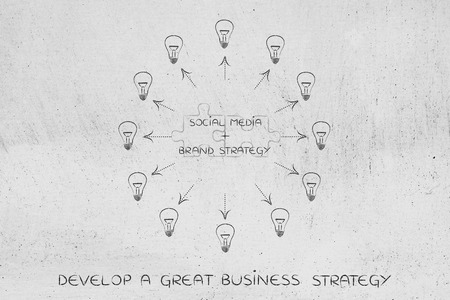Understanding the Difference Between Ambition and Realism
When it comes to building a startup in America, ambition and realism are both key players—but they aren’t the same thing. Ambition is what pushes you to dream big, take risks, and aim for those “unicorn” outcomes that make headlines. In American startup culture, ambition is often seen as the fuel that powers innovation and drives founders to create something truly disruptive.
What Does Ambition Mean in the American Startup Context?
In the U.S., ambition is celebrated. It means setting bold goals, thinking beyond your current resources, and not being afraid to challenge the status quo. Investors, mentors, and even customers often look for founders who have a clear vision of what they want to achieve—even if it seems out of reach right now.
Examples of Ambitious Goals in Startups:
| Ambitious Goal | Real-World Example |
|---|---|
| Disrupt an entire industry | Uber aiming to change global transportation |
| Reach millions of users quickly | Instagram’s rapid user growth after launch |
| Create technology that doesn’t exist yet | Tesla’s push for self-driving cars |
How Does Realism Fit In?
While ambition helps you think big, realism keeps your feet on the ground. Realism means understanding where you are right now—your resources, your team’s capabilities, and what’s actually possible given your market conditions. In the American startup scene, being realistic is just as important as being ambitious because it helps you avoid burnout, save money, and adjust when things don’t go as planned.
Key Differences Between Ambition and Realism:
| Ambition | Realism | |
|---|---|---|
| Focuses on… | The big picture and future possibilities | Your current situation and practical steps forward |
| Makes decisions based on… | Vision and dreams | Facts, data, and existing constraints |
| Main risk is… | Overreaching or burning out | Lack of progress or missing opportunities |
Why Balance Matters in the U.S. Startup Journey
If you lean too far into ambition without enough realism, you might waste time or money chasing impossible goals. On the other hand, if you’re too realistic and cautious, you could miss out on breakthrough moments that set your company apart. The best American startups find a way to balance both—using ambition to set exciting targets and realism to guide their everyday decisions.
2. Setting Bold Yet Achievable Goals
Setting goals is a crucial part of every startup journey, but it’s easy to get caught up in the excitement and set targets that are either too ambitious or too safe. Striking the right balance means creating milestones that stretch your team’s capabilities without setting them up for burnout or disappointment.
Why Balance Matters
Ambitious goals fuel motivation and attract talent, investors, and customers. But if your targets are unrealistic, you risk overcommitting your resources and losing momentum. On the flip side, goals that are too easy can lead to stagnation and missed opportunities for growth. It’s all about finding that sweet spot.
Steps to Set Bold Yet Achievable Goals
| Step | Description | Example |
|---|---|---|
| 1. Define Your Vision | Paint a big-picture view of where you want your startup to be in 3-5 years. | Become a leading online platform for eco-friendly home goods in the U.S. |
| 2. Break Down Your Vision into Milestones | Create smaller, time-bound goals that move you toward your vision. | Reach 10,000 monthly active users within the first year. |
| 3. Assess Resources Honestly | Look at your team, budget, and time. Don’t ignore limitations—plan around them. | If you have a team of three, don’t aim to launch five products at once. |
| 4. Involve Your Team | Get input from everyone involved to ensure buy-in and realistic planning. | Hold a weekly check-in to discuss progress and roadblocks together. |
| 5. Measure and Adjust Regularly | Track progress and be flexible. If something isn’t working, pivot quickly. | If you’re only halfway to your user goal after six months, tweak your marketing strategy. |
The Power of Milestones
Milestones serve as checkpoints—they let you celebrate small wins along the way while keeping your eyes on the bigger prize. They also help prevent overwhelm by breaking complex projects into manageable steps. This keeps morale high and teams motivated even when challenges arise.
Tips for Setting Effective Milestones
- Be Specific: Clearly define what success looks like for each goal.
- Set Deadlines: Assign realistic timelines to create urgency without pressure.
- Stay Flexible: Be open to revisiting and adjusting goals as circumstances change.
- Praise Progress: Recognize achievements—even small ones—to keep energy up.
Your Takeaway
The most successful startups dream big but plan smart. By setting bold yet achievable goals—and regularly checking in with your team—you’ll inspire innovation without stretching resources too thin. This approach helps you build not just a business, but a culture of sustainable growth.

3. Embracing Adaptability and Learning from Failure
Every startup journey comes with its fair share of bumps in the road. While ambition pushes you to reach higher, realism keeps your feet on the ground. But what really ties these together is adaptability—your ability to adjust when things don’t go as planned. In the U.S. startup culture, “fail fast, learn faster” is more than just a saying; it’s a survival strategy.
Seeing Setbacks as Stepping Stones
Instead of viewing setbacks as dead-ends, successful entrepreneurs see them as valuable lessons. Each challenge or mistake offers insight into what works and what doesn’t, helping you fine-tune your approach for the next round. The key is not to let disappointment kill your drive. Remember, even the biggest names in tech had failures before hitting it big.
How to Turn Setbacks Into Learning Opportunities
| Setback | Learning Opportunity | Action Step |
|---|---|---|
| Poor product launch | Identify market misfit or communication gaps | Gather customer feedback, tweak messaging or features |
| Running out of funds | Analyze spending patterns and revenue streams | Adjust budget, explore new funding options |
| Losing a key team member | Spot gaps in company culture or workload distribution | Improve onboarding, clarify roles, foster teamwork |
Staying Motivated After a Setback
Bouncing back isn’t always easy. Here are a few simple ways to keep your entrepreneurial spirit alive:
- Reflect without blame: Focus on what happened and why—without pointing fingers.
- Celebrate small wins: Recognize progress, no matter how minor it seems.
- Connect with other founders: Sharing war stories can remind you that you’re not alone.
- Create a flexible plan: Make adjustments but keep your long-term vision in sight.
The American Mindset: Resilience Over Perfection
The culture around startups in America values resilience over perfection. Investors and mentors appreciate founders who can acknowledge mistakes, pivot quickly, and keep moving forward. If you embrace this mindset, balancing ambition with realism becomes much easier—and your chances of long-term success will grow along with your ability to adapt.
4. Building a Support Network for Reality Checks
As you push your startup forward, it’s easy to get caught up in big dreams or, on the flip side, become overwhelmed by challenges. That’s why surrounding yourself with the right people is key to staying both ambitious and realistic. Let’s break down how mentorship, peer feedback, and networking can help keep your feet on the ground while reaching for the stars.
Why a Support Network Matters
No founder succeeds alone. In the U.S. startup scene, having a strong support network is almost a rite of passage. It provides:
- Honest Feedback: People who tell it like it is, not just what you want to hear.
- Fresh Perspectives: Different backgrounds bring new solutions and ideas.
- Emotional Backup: Entrepreneurship can be lonely—having someone in your corner matters.
The Power of Mentorship
A mentor can be your personal GPS through the ups and downs. They’ve been there, done that, and can warn you about common pitfalls or validate your strategies when you’re unsure.
Ways Mentors Help Balance Ambition and Realism
| Mentor Role | How It Helps |
|---|---|
| Sounding Board | Gives honest opinions on your bold ideas |
| Experience Sharer | Tells real stories so you know what’s truly possible |
| Connector | Introduces you to others who can help fill knowledge gaps |
The Value of Peer Feedback
Your fellow founders are in the trenches with you. They understand your day-to-day struggles and wins better than anyone else. Regular meetups or mastermind groups let you swap advice and reality checks in a safe space.
Tips for Getting Useful Peer Feedback
- Be open about your challenges, not just your successes.
- Ask specific questions to get actionable advice.
- Return the favor—helping others sharpens your own thinking.
Networking: More Than Just Business Cards
In American business culture, networking isn’t only about exchanging contacts—it’s about building relationships that last. Attending events, joining online forums, or even grabbing coffee with someone new can lead to collaborations, partnerships, or unexpected opportunities that help keep your ambitions in check with real-world insights.
Quick Networking Checklist
- Set clear goals before each event (e.g., learn about funding trends)
- Follow up after meetings—relationships grow over time
- Diversify your network; different industries offer fresh viewpoints
A strong support network acts as both cheerleader and reality check. By tapping into mentorship, peer feedback, and broader networks, you’ll stay motivated but also grounded—exactly what every founder needs for long-term success.
5. Staying Motivated Without Losing Perspective
Why Motivation and Perspective Matter
Building a startup is a wild ride—some days you’re on top of the world, other days you wonder what you’ve gotten yourself into. Keeping your motivation high is important, but it’s just as crucial to stay grounded and make decisions based on reality, not just dreams.
Practical Tips to Stay Energized and Balanced
1. Set Achievable Milestones
Break your big goals into smaller, realistic milestones. Celebrate small wins; they boost your confidence and keep the team’s energy up.
| Ambitious Goal | Realistic Milestone |
|---|---|
| Get 10,000 users in 6 months | Reach 500 users by end of month 1 |
| Launch nationwide | Pilot launch in one city first |
| Secure $1M in funding | Pitch to 5 local investors this quarter |
2. Listen to Real-World Feedback
Your vision matters, but customer feedback is gold. Regularly ask for honest input from real users and mentors. It keeps your business idea aligned with what people actually want—and helps avoid costly mistakes.
3. Protect Your Mental Health
Bottling up stress or ignoring burnout won’t help anyone—not you, not your company. Make time for breaks, talk openly about challenges with your team, and don’t hesitate to seek support if things get overwhelming. Even top founders use therapists or coaches.
4. Keep Your “Why” Front and Center
It’s easy to lose sight of why you started when things get tough. Remind yourself and your team about your mission regularly—put it on the wall, bring it up in meetings, and tie everyday tasks back to your bigger purpose.
Quick Checklist: Staying Motivated & Grounded
- Review goals weekly and adjust as needed based on progress and feedback
- Celebrate wins (even small ones) with your team—pizza parties count!
- Check in on each other’s well-being; mental health is a team effort
- Stay curious—see failures as learning opportunities, not dead ends
- Talk to customers often; let their needs shape your next steps
You don’t have to choose between dreaming big and staying realistic—they work best together when you make them part of your daily routine.


